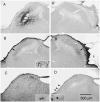Recombinant adeno-associated virus vector: use for transgene expression and anterograde tract tracing in the CNS
- PMID: 9630611
- PMCID: PMC4961038
- DOI: 10.1016/s0006-8993(98)00169-3
Recombinant adeno-associated virus vector: use for transgene expression and anterograde tract tracing in the CNS
Abstract
We used a recombinant adeno-associated virus vector (AAV) to deliver a foreign gene, green fluorescent protein (GFP), into mature neurons in adult rat CNS in vivo. Microinjections of AAV as small as 50 nl transduced hundreds of neurons at the injection site. There was virtually no retrograde transport as fewer than one neuron per brain was found distant from the injection site that exhibited GFP immunoreactivity. The gene product, GFP, filled the entire neuronal cytoplasmic compartment; GFP immunoreactivity was robust in cell bodies, axons, and nerve terminals. There was no tissue damage at the injection sites or pathogenicity indicated by changes in astrocytic or microglial markers. There was no inflammatory response as judged by leukocytic invasion. Gene expression in transduced cells was robust and apparently permanent: there was no evidence of phenotypic reversion up to 12 weeks following infection. AAV is an excellent vector for introducing foreign genes into mature CNS neurons. Not only might it be an ideal vehicle for gene therapy, but also the GFP-containing AAV presents a new strategy for tracing long axonal pathways in the CNS, which is difficult with current tracers (PHAL, biotinylated dextrans).
Copyright 1998 Elsevier Science B.V.
Figures





Similar articles
-
Efficient delivery of Cre-recombinase to neurons in vivo and stable transduction of neurons using adeno-associated and lentiviral vectors.BMC Neurosci. 2004 Jan 30;5:4. doi: 10.1186/1471-2202-5-4. BMC Neurosci. 2004. PMID: 15005815 Free PMC article.
-
High-brightness anterograde transneuronal HSV1 H129 tracer modified using a Trojan horse-like strategy.Mol Brain. 2020 Jan 13;13(1):5. doi: 10.1186/s13041-020-0544-2. Mol Brain. 2020. PMID: 31931837 Free PMC article.
-
Adeno-associated viral vector gene expression in the adult rat spinal cord following remote vector delivery.Neurobiol Dis. 2003 Dec;14(3):535-41. doi: 10.1016/j.nbd.2003.08.025. Neurobiol Dis. 2003. PMID: 14678769
-
Basic fibroblast growth factor enhances transduction, distribution, and axonal transport of adeno-associated virus type 2 vector in rat brain.Hum Gene Ther. 2004 May;15(5):469-79. doi: 10.1089/10430340460745793. Hum Gene Ther. 2004. PMID: 15144577
-
Intersectional targeting of defined neural circuits by adeno-associated virus vectors.J Neurosci Res. 2021 Apr;99(4):981-990. doi: 10.1002/jnr.24774. Epub 2020 Dec 20. J Neurosci Res. 2021. PMID: 33341969 Free PMC article. Review.
Cited by
-
Assessment of the AAV-mediated expression of channelrhodopsin-2 and halorhodopsin in brainstem neurons mediating auditory signaling.Brain Res. 2013 May 20;1511:138-52. doi: 10.1016/j.brainres.2012.10.030. Epub 2012 Oct 23. Brain Res. 2013. PMID: 23088961 Free PMC article. Review.
-
Glutamatergic signaling from the parabrachial nucleus plays a critical role in hypercapnic arousal.J Neurosci. 2013 May 1;33(18):7627-40. doi: 10.1523/JNEUROSCI.0173-13.2013. J Neurosci. 2013. PMID: 23637157 Free PMC article.
-
High-throughput dual-colour precision imaging for brain-wide connectome with cytoarchitectonic landmarks at the cellular level.Nat Commun. 2016 Jul 4;7:12142. doi: 10.1038/ncomms12142. Nat Commun. 2016. PMID: 27374071 Free PMC article.
-
The expression of MC4Rs in D1R neurons regulates food intake and locomotor sensitization to cocaine.Genes Brain Behav. 2013 Aug;12(6):658-65. doi: 10.1111/gbb.12057. Epub 2013 Jul 17. Genes Brain Behav. 2013. PMID: 23786641 Free PMC article.
-
Intraneuronal aggregate formation and cell death after viral expression of expanded polyglutamine tracts in the adult rat brain.J Neurosci. 2000 Jan 1;20(1):219-29. doi: 10.1523/JNEUROSCI.20-01-00219.2000. J Neurosci. 2000. PMID: 10627599 Free PMC article.
References
-
- Bernard JF, Alden M, Besson JM. The organization of the efferent projections from the pontine parabrachial area to the amygdaloid complex: a phaseolus vulgaris leucoagglutinin (PHA-L) study in the rat. J Comp Neurol. 1993;329:201–229. - PubMed
-
- Chamberlin NL, Saper CB. Differential distribution of AMPA-selective glutamate receptor subunits in the parabrachial nucleus of the rat. Neuroscience. 1995;68:435–443. - PubMed
-
- Du B, Wu P, Boldt-Houle DM, Terwilliger EF. Efficient trans-duction of human neurons with an adeno-associated virus vector. Gene Ther. 1996;3:254–261. - PubMed
-
- Earle KL, Mitrofanis J. Identification of transient microglial cell colonies in the forebrain white matter of developing rats. J Comp Neurol. 1997;387:371–384. - PubMed
-
- Feil K, Herbert H. Topographic organization of spinal and trigemi-nal somatosensory pathways to the rat parabrachial and Kolliker– Fuse nuclei. J Comp Neurol. 1995;353:506–528. - PubMed
Publication types
MeSH terms
Substances
Grants and funding
LinkOut - more resources
Full Text Sources
Other Literature Sources

